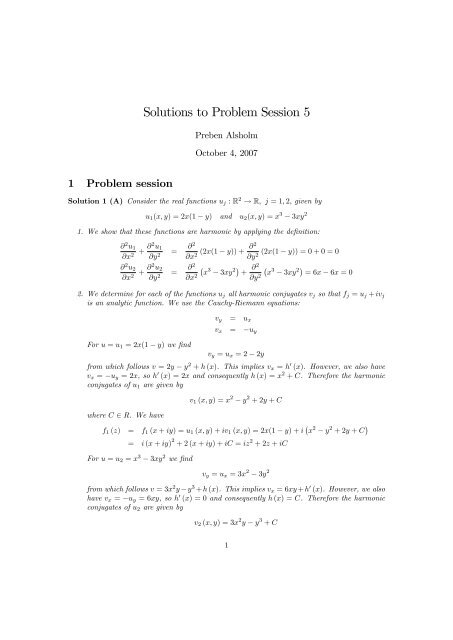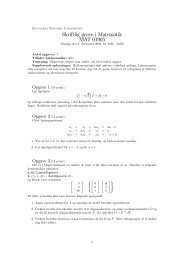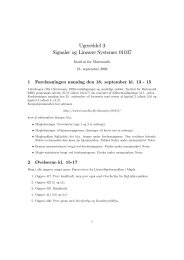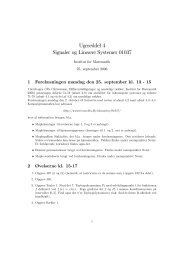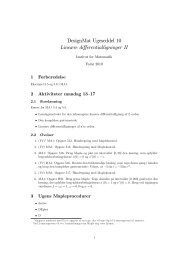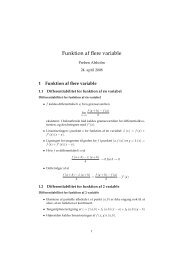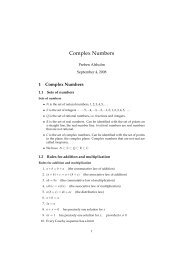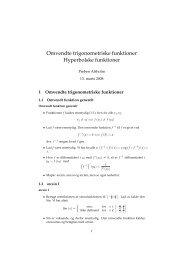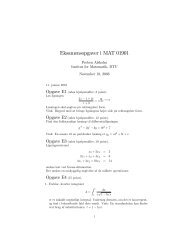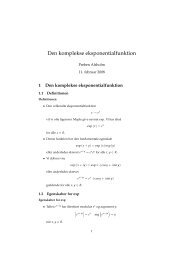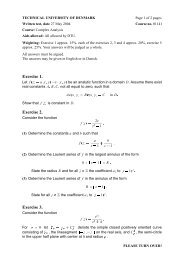Solutions to Problem Session 5
Solutions to Problem Session 5
Solutions to Problem Session 5
You also want an ePaper? Increase the reach of your titles
YUMPU automatically turns print PDFs into web optimized ePapers that Google loves.
<strong>Solutions</strong> <strong>to</strong> <strong>Problem</strong> <strong>Session</strong> 5<br />
Preben Alsholm<br />
Oc<strong>to</strong>ber 4, 2007<br />
1 <strong>Problem</strong> session<br />
Solution 1 (A) Consider the real functions u j : R 2 ! R; j = 1; 2; given by<br />
u 1 (x; y) = 2x(1 y) and u 2 (x; y) = x 3 3xy 2<br />
1. We show that these functions are harmonic by applying the de…nition:<br />
@ 2 u 1<br />
@x 2 + @2 u 1<br />
@y 2 = @2<br />
@2<br />
(2x(1 y)) + (2x(1 y)) = 0 + 0 = 0<br />
@x2 @y2 @ 2 u 2<br />
@x 2 + @2 u 2<br />
@y 2 = @2<br />
@x 2 x3 3xy 2 + @2<br />
@y 2 x3 3xy 2 = 6x 6x = 0<br />
2. We determine for each of the functions u j all harmonic conjugates v j so that f j = u j + iv j<br />
is an analytic function. We use the Cauchy-Riemann equations:<br />
For u = u 1 = 2x(1<br />
y) we …nd<br />
v y = u x<br />
v x = u y<br />
v y = u x = 2<br />
from which follows v = 2y y 2 + h (x). This implies v x = h 0 (x). However, we also have<br />
v x = u y = 2x, so h 0 (x) = 2x and consequently h (x) = x 2 + C. Therefore the harmonic<br />
conjugates of u 1 are given by<br />
2y<br />
v 1 (x; y) = x 2<br />
y 2 + 2y + C<br />
where C 2 R. We have<br />
f 1 (z) = f 1 (x + iy) = u 1 (x; y) + iv 1 (x; y) = 2x(1 y) + i x 2 y 2 + 2y + C <br />
= i (x + iy) 2 + 2 (x + iy) + iC = iz 2 + 2z + iC<br />
For u = u 2 = x 3<br />
3xy 2 we …nd<br />
v y = u x = 3x 2 3y 2<br />
from which follows v = 3x 2 y y 3 + h (x). This implies v x = 6xy + h 0 (x). However, we also<br />
have v x = u y = 6xy, so h 0 (x) = 0 and consequently h (x) = C. Therefore the harmonic<br />
conjugates of u 2 are given by<br />
v 2 (x; y) = 3x 2 y<br />
y 3 + C<br />
1
where C 2 R. We have<br />
f 2 (z) = f 2 (x + iy) = u 2 (x; y) + iv 2 (x; y) = x 3 3xy 2 + i 3x 2 y y 3 + C <br />
= (x + iy) 3 + iC = z 3 + iC<br />
Solution 2 (B) Consider any branch of the logarithm of the form<br />
L (z) = ln jzj + i arg (z);<br />
where arg (z) 2]; + 2]:<br />
v(z) = arg (z) is a harmonic function in the slit plane D = C n fre i j r 0g; because L (z)<br />
is analytic in D . It is not harmonic in C n f0g for the simple reason that it is not continuous<br />
there.<br />
Let D be a domain given as the union of two domains D = D 1 [ D 2 . If u : D ! R is harmonic<br />
in D 1 and in D 2 , then u is harmonic in D, since <strong>to</strong> be harmonic in some set means <strong>to</strong> satisfy<br />
Laplace’s di¤erential equation u = 0 in each point of the set. This simple fact implies that<br />
u(z) = ln jzj is a harmonic function in C n f0g it is the real part of both Log (z) and L 0 (z).<br />
Solution 3 (C) We shall …nd a function u which is harmonic in the region sketched in …g.<br />
3.12. We use<br />
(x; y) = A arg (z 1 i) + B<br />
4<br />
since arg (z 1 i) is the imaginary part of L (z 1 i) which is analytic in the region.<br />
4 4<br />
Imposing the boundary condtions gives<br />
10 = (x; 1) = A 0 + B; x > 1<br />
3<br />
0 = (1; y) = A + B; y < 1<br />
2<br />
Thus B = 10 and A = 20<br />
3 so (x; y) = 20<br />
3 arg (z 1 i) + 10<br />
4<br />
The value at (0; 0) is (0; 0) = 20<br />
3 arg 20 5<br />
( 1 i) + 10 =<br />
4 3 4 + 10 = 5 3 .<br />
Solution 4 (D)<br />
1. Consider the …rst Example on p. A-22:<br />
w = f(z) = z 2<br />
and the domain, the half strip,<br />
D = f z = x + iy j 0 < x < 1 ^ y > 0 g<br />
The domain D is bounded by the three curves<br />
1 : z = iy; y 0 ; 2 : z = x; 0 x 1 ; 3 : z = 1 + iy; y 0<br />
We …nd<br />
f (iy) = y 2 so f ( 1 ) = R [ f0g<br />
f (x) = x 2 so f ( 2 ) = [0; 1]<br />
f (1 + iy) = (1 + iy) 2 = 1 y 2 + 2iy<br />
2
so f ( 3 ) is the upper branch of the parabola u = 1<br />
1<br />
4 v2 in the uv-plane.<br />
That f is conformal in D follows from f 0 (z) = 2z 6= 0 in D. That f maps D injectively,<br />
hence bijectively on<strong>to</strong> E = f(D) follows from<br />
z 2 1 = z 2 2 , z 1 = z 2<br />
and from the fact that not both of z 2 can belong <strong>to</strong> D.<br />
The inverse function f 1 : E ! D is a square root, and it is the principal branch of the<br />
square root, since D belongs <strong>to</strong> the right half plane.<br />
2. Consider the last Example on p. A-22:<br />
and the domain, the strip,<br />
w = f(z) = e z<br />
D = f z j 0 < Im z < g<br />
f is conformal in D since the derivative is clearly di¤erent from zero. f maps D injectively,<br />
hence bijectively on<strong>to</strong> the upper half plane E = f(D), since it is injective in the larger strip<br />
f z j < Im z g. The inverse function f 1 : E ! D is the well-known function<br />
Log.<br />
Solution 5 (E) We consider the sine function in the …rst Example on p. A-24.<br />
1. The vertical half-lines which bound the half strip S + given as<br />
S + = f z = x + iy j jxj < 2<br />
are given by z = 2<br />
+ iy; y > 0. We …nd<br />
<br />
<br />
sin<br />
2 + iy = 1 2i<br />
<br />
exp<br />
<br />
i 2<br />
<br />
y<br />
^ y > 0 g<br />
<br />
exp<br />
i 2 + y <br />
= 1 2i<br />
ie y + ie y = cosh y<br />
and also<br />
<br />
sin<br />
<br />
2 + iy <br />
= 1 2i<br />
<br />
exp<br />
i 2<br />
<br />
y<br />
exp<br />
i <br />
2 + y<br />
= 1 2i<br />
ie y ie y = cosh y<br />
Thus the vertical half-line <strong>to</strong> the right is mapped on<strong>to</strong> ]1; 1[ and the vertical half-line <strong>to</strong><br />
the left is mapped on<strong>to</strong> ] 1; 1[.<br />
The sine function is conformal in S + since its derivative cos is di¤erent from zero in S + .<br />
We have<br />
sin (x + iy) = sin x cosh y + i cos x sinh y<br />
Since the imaginary part is positive sin(S + ) is at least a part of the upper half-plane.<br />
Keeping y > 0 …xed and letting x 2 <br />
2 ; <br />
2 vary we see that u + iv = sin (x + iy) takes on<br />
all values on the upper half of the ellipse<br />
u 2<br />
cosh 2 y +<br />
v2<br />
sinh 2 y = 1<br />
When y increases from 0 and up the ellipse expands from being just the real line segment<br />
] 1; 1[ <strong>to</strong> being larger and larger having semi-axes cosh y and sinh y. Thus we see that<br />
sin(S + ) is the upper half-plane.<br />
3
2. By using that exp z = exp (z) we get<br />
sin z = 1 2i (eiz e iz ) = 1 2i<br />
e iz<br />
e iz = sin z<br />
3. By using sin z = sin z we see that the lower strip S = f z = x + iy j jxj < 2 ^ y < 0 g is<br />
mapped bijectively on<strong>to</strong> the lower half-plane.<br />
4


